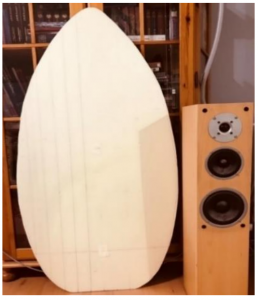With the fall of Roman Western Empire, techniques for concrete construction were lost. People admired the ancient buildings for hundres of years, hoping that one day civilization will regain its lost knowledge one day. In a similar way, a few years ago audio DIY communities were swept by the newest rediscovery – giant free-hanging panels to which an exciter is attached, creating vibrations that practically turn the panel into a giant source of sound. Panel speakers have been around at least since the 60’s, but now the technology is advanced enough that any teen with a hammer and a nail can build one themselves. But should they?

What is it like to listen to such a speaker? Some people say it’s like listening to a live school orchestra performing film music: you can hear it all over the place but every now and then some messes up their part. Why? Panel speakers have more on their plate than normal speakers. Because of their complexity, they vibrate in not 2, not 3, but 4 distinct types of waves! You might ask: wait, weren’t there supposed to be only longitudinal (sound-like) and tranverse (water-like) waves in physics? Well, this is what a teen with a hammer and a nail believes, and this is what makes him and his panels wrong.
Unmoving panel cross-section

Panel vibrating a quasi-longitudinal wave

Panel speakers also exhibit other types of waves, for instance the quasi-longitudinal wave. This means that the panel stretches and compresses (just like air molecules), but if you look only at the surface, the wave looks tranverse. Another type of wave is the bending wave, which looks either like an earthquake or a falling stack of books depending on how you look at it. It is a combination of tranverse and logitudinal waves.
Panel vibrating a bending wave

Bending wave is the real hair in the soup of panel speaker enthusiasts, because it is frequency dependent. This means that however we design a panel speaker, it will produce a different vibration and hence a different sound for specific tones in a piece of music – essentially distorting your favourite jams.
Another problem arises when with the resonance: panel speakers love to resonate in different frequencies with transverse waves. You might notice this when you get to listen to your big bass speakers in a living room on a Sunday morning and hear your glasses clanking in a cupboard on the drop. This is because whenever a frequency is played, a corresponding wave exists, that might just happen to be the length of a piece of glassware. In panel speakers specifically, a resonance might occur because a wave is established between an exciter and an edge of the panel. Because most panel speakers are rectangles, the resonance occurs for some frequencies and not for others, creating what you might call a false tune. When I used to be a teen with a nail and a hammer, I once tried to get away with that problem making an egg-shapped speaker: if you put an exciter on the bottom of such a panel, theoretically almost all waves resonate equally, so it seems logical that all frequencies should have the same loudness.

The bending waves are notoriously hard to please though: the resonance of bending waves depends on the frequency in a non-linear way! This means that there is more resonance for some frequencies than others if the radius of the egg increases linearly, which is necessary for an equal response for transverse waves. A solution for one type of a wave creates problem for a different type. This is why panel speakers are difficult to create on par with traditional speakers, and why the technology is ditched every now and then. Perhaps better computational models will bring improved giant speakers in the future. If you could get an AI to test different shapes of speakers, for instance, it could analyze how the vibration interact with each other to create sound and find a design that has the least mean difference between the loudness of all frequencies. For now, however, we can enjoy just this: a crazed orchestra of different waves dancing on the biggest speakers you’ve ever seen.
Angus, J. Distributed Mode Loudspeaker Resonance Structures. Journal of the Audio Engineering Society 5217, (2000). http://www.aes.org/e-lib/browse.cfm?elib=9121
